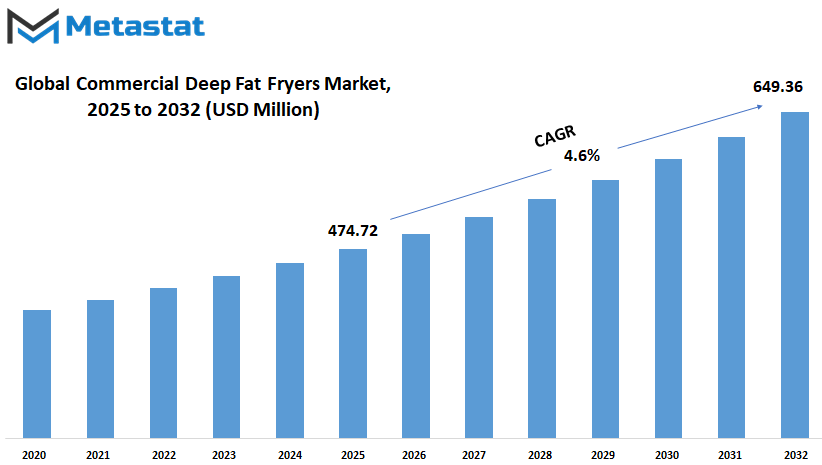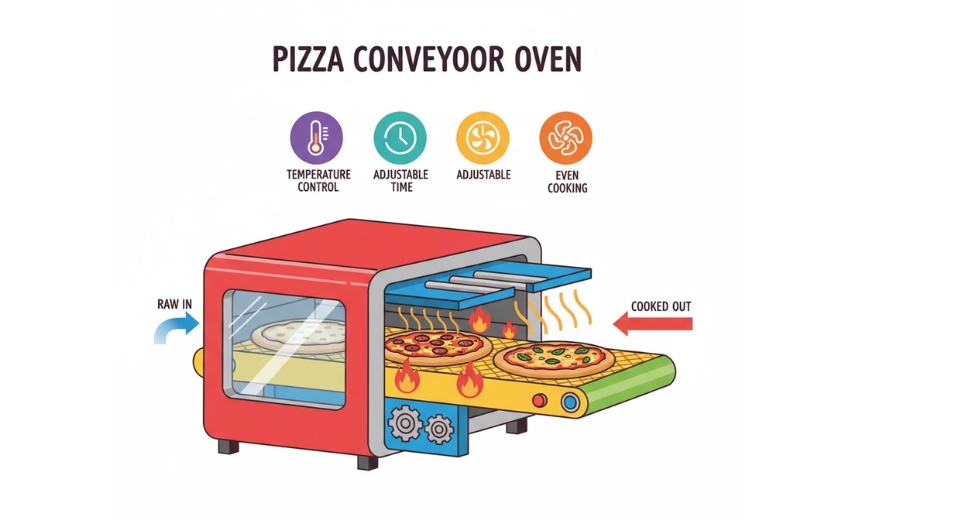MARKET OVERVIEW
The Global Commercial Deep Fat Fryers market is one of the major markets in the wider foodservice equipment industry. Demand for these fryers comes primarily from restaurants, fast-food chains, hotels, and other commercial kitchens all around the world. In the production, distribution, and utilization of deep fat fryers to accommodate high-volume food preparation, this is considered. These fryers are very critical in providing the food products and a consistent experience in frying: whether it be French fries, chicken, fish, and newer fast foods and making them unremovable pieces in the commercial kitchen of modern times.
Prospects for continuing growth in foodservice markets all over the globe, the market for Global Commercial Deep Fat Fryers will not have any end in the increase in demand with the established company and the one emerging in foodservice. The various types of fryers that will be there in the market are gas, electric, which is diverse, yet it's the main business as far as catering to the need for preparing food is concerned. There will be companies who have been and still continue to innovate with versions using less oil while not diminishing the quality of food prepared by means of their equipment.
There are more profound equipment sales for a Global Commercial Deep Fat Fryers market than merely that. Maintenance, repairing, and replacement of components will all be Aftermarket and it is that marketplace which will also have to underwrite the Life Span of those operations. The market shall therefore also be affected further by regulative standards relative to energy consumptions, to food safety issues, and for environmental impact reasons. This means that business will also have to improve, irrespective of the response to any new regulation, on the efficiency parameters of the operation.
The market would reach geographically in North America, Europe, Asia-Pacific, Latin America, and the Middle East & Africa. The opportunities as well as the challenges for each region, however, would differ depending on the preferences, the regulatory framework, and the economic dynamics. The North American and European markets will focus more on energy efficiency and sustainability. Demand will come primarily from the Asia-Pacific region because of foodservice sector growth and urbanization. Latin American and African economies are emerging with higher disposable incomes and changes in lifestyle that add to the expansion of the market.
In terms of technology, tremendous breakthroughs will be observed in automation and integration with smart kitchen in the Global Commercial Deep Fat Fryers market. The trend for IoT-enabled fryers allows the operators to manage and monitor their remote cooking process without compromise in food quality while keeping the operating costs lower. Healthy food demand will also spur low oil fryers as consumers are shifting toward low-fat food.
The market will be highly competitive in nature, having features of product differentiation, strategic alliances, and a global network for distribution. R&D will have significant investments for performance and efficiency improvement in the product offered with minimal energy consumption and long periods of utilization of equipment. The price and after-sales service will emerge as prime decision-making factors while making a buy with increased competition.
The Global Commercial Deep Fat Fryers market will continue to evolve as it adapts to changing consumer demands, technological advancements, and regulatory frameworks. This dynamic market will offer numerous opportunities for manufacturers, distributors, and service providers, making it a vital component of the global foodservice equipment industry.
Global Commercial Deep Fat Fryers market is estimated to reach $649.36 Million by 2032; growing at a CAGR of 4.6% from 2025 to 2032.

GROWTH FACTORS
The Global Commercial Deep Fat Fryers market is going to increase manifold in the following coming years due to several driving factors: changing consumer preferences as well as advances in technology. This growth primarily attributes to a huge demand for fried fast foods, especially within quick-service restaurants. As lifestyles have been hastened, people are shifting towards consuming convenient foods that can easily be prepared and served. They appropriately fit into such demands, and fast food chains are still widely spreading across the globe. Being deep fat fryers-dependent they have maintained food preparation consistency with speed, thereby influencing the market demand directly.
The other prominent driver of this Global Commercial Deep Fat Fryers market is the non-stop advancement of frying technology. The manufacturers are developing energy-saving and automated deep fat fryers that not only save on operational cost but also improve their performance. With such inventions, businesses not only save money on energy but also get better quality food from frying, since it becomes much more precise and constant. Such programmable setting and also real-time monitoring capability makes it very easy for operators to handle huge operations of frying in a congested commercial kitchen.
Despite these positive aspects, there are some potential reasons that can prevent the growth of the market. The primary factor that can restrain the growth of the market is the growing awareness of public health against eating fried food items. With growing health awareness, the high-fat diet will continue to be under the scanner. This again may impede the demand for deep-fried food. To some extent, the high initial investment and expenditure in maintenance of advanced machines will discourage small-sized businesses to change their equipment. In this sector, market growth will be mainly concentrated in the hands of big businesses well-established with funds.
On a positive note, some appealing opportunities are in store for the Global Commercial Deep Fat Fryers market. Due to the rapid rise in health-conscious frying, such openings for growth and expansion are currently being opened. Some of the new lines of innovation are designed to meet business needs for food that is deemed healthier but taste is not affected, which include increasing air fryers and superior oil filtration technology. Oil Filtration for instance, lengthens the life of oil and removes a lot of carcinogens, while the fried foods produced are a little healthier and cheaper on the business side as well. Such healthier frying products going forward with technology advancement are expected to enjoy more buyers and expand the market further.
While there are health concerns and very high costs associated with the Global Commercial Deep Fat Fryers market, but there still remain strong demand factors of very fast food, often fried, and technological advancements in frying. The future of this industry will depend on how it responds to health trends through the introduction of modern technologies.
MARKET SEGMENTATION
By Type
The Global Commercial Deep Fat Fryers market is likely to grow steadily in the following years as food industries demand its increase. More restaurants, fast-food chains, and catering businesses open up, thus making reliable frying equipment ever so more critical for the commercial operation. Growing fried food usage globally has propelled business into more and more of a high-end quality fryer purchase in light of the current customers' need for quality goods.
There are two primary types of markets for gas commercial deep fryers and electric commercial deep fryers. Gas is normally used for a large-scale operation because it can heat oil very fast to an even temperature. This helps cook food evenly without waste. For restaurants that conduct high volume frying, including fast-food and large commercial operations, gas commercial deep fryers are preferred. Gas fryers are also normally cheaper in locations where gas costs less than electricity, making gas fryers cheaper in regions that have relatively lower natural gas.
On the other hand, Electric Commercial Deep Fryers are popular in areas of very sensitive environmental legislation. They earned their popularity due to their high energy efficiency, despite requiring easy usage. They offer temperature control and will not compromise the quality and consistency of food, making them one of the best fryers out there. Furthermore, they are also simple installation, as they do not need complicated gas line setting-ups. This makes them ideal for small businesses, food trucks, and establishments where space and safety are concerns. Moreover, with advancements in technology, more energy-efficient electric models have been developed that can reduce the operational costs in the long term. Technological innovations are expected to play a major role in shaping the Global Commercial Deep Fat Fryers market in the future.
The more advanced fryers with features like automated temperature control, oil filtration systems, and energy-saving modes are increasingly gaining popularity. The quality of food is improved not only by the equipment but also by its increased lifespan and reduction in maintenance costs. Sustainability is also going to increase demand since many businesses focus on this factor. Thus, less oil and energy consumption with higher performance will remain a demand in fryers. The global commercial deep fat fryers market will continue to boom with expansion of the food industry and how it continues. Each of these gas fryers has its own merits, though electric fryers offer easy performance. Future developments in technology will enhance these fryers to make them more efficient and productive. Businesses will seek fryers that cater to their cooking needs as well as fit into the sustainability goals and cost-saving strategies of such business organizations.
By Distribution Channel
The Global Commercial Deep Fat Fryers market is expected to experience tremendous growth in the coming years, driven by shifts in consumer behavior, technological advancements, and changes in distribution channels. With the food industry growing globally, there is a rising demand for efficient, high-capacity cooking equipment. Restaurants, fast food chains, and catering services are increasingly relying on deep fat fryers to meet the growing need for fried foods, which remain a staple in many cuisines worldwide. This demand is not only from traditional food establishments but also from newer, innovative food businesses that are shaping the future of the industry.
One of the central factors driving change in the Global Commercial Deep Fat Fryers market is how companies get their goods to customers' doors. There are three significant channels: distribution, direct sale, and ecommerce. Each presents a unique segment of the markets and will persist in shaping commercial equipment purchasing operations. Direct selling is often chosen by larger buyers who require tailormade equipment and long-lasting relationships with sellers. This approach will give the businesses better control over their purchases to ensure that the equipment is fit for their purposes. Distributors are middlemen who provide a variety of products from various manufacturers. They are convenient and accessible, especially to small businesses, which cannot afford to deal directly with manufacturers.
E-commerce is the fastest-growing distribution channel in the Global Commercial Deep Fat Fryers market. It's no wonder that online sites have been a vital alternative in acquiring equipment nowadays as digital technology continues to penetrate more in business operations. Shopping through several products, comparing prices, and checking customer reviews can be quite easy on the online sites. Furthermore, improvements of logistics and supply chain management enable commercial fryers to easily reach far distances. This trend will increase even more in the future because most businesses are concerned with convenience and efficiency in making purchasing decisions.
Going forward, the Global Commercial Deep Fat Fryers market will continue to change as businesses adapt to changing consumer demands and technological innovations. By the development of smart kitchen appliances, future commercial fryers will most likely improve automation, energy efficiency, and safety aspects more. These innovations will not only enhance the cooking performance of their services but also increase operational efficiency for businesses. With growth in this market, the channels for distribution also expand, with e-commerce growing tremendously to have greater dominance. This will define the future of the food industry as well as how business is conducted globally.
By Application
The Global Commercial Deep Fat Fryers market is growing rapidly since the past couple of years and is expected to continue growing forward because of rising demand for fried food in most sectors. However, consumer trends for quick tasty meals are a major driving factor for the sector. Among other applications, some of the largest industries that utilize these fryers include food service, catering services, and institutional food services, which are contributing to the general trend of this market.
The food service industry is the largest and most influential sector that utilizes commercial deep fat fryers. Restaurants, fast-food chains, and other fast-food establishments need efficient equipment to accommodate the ballooning demand for fried foods as more people dine out. There can never be enough emphasis on the importance of these fryers in preparing fries and chicken, among many other popular snacks, which are staples in almost every menu worldwide. Some businesses also are exploring fryers with advanced features that help in reducing oil usage, thereby making them more energy-efficient and environmentally friendly as regions shift towards healthier options.
Another key segment catering services also relies heavily on commercial deep fat fryers to prepare large quantities of food quickly. Catering companies require reliable equipment, be it for weddings, corporate events, or private parties, so that the dishes prepared by them are not only delicious but also prepared within the given time. With increasing complexity in events and the demand for high-quality food, advanced fryers will continue to rise to handle large volumes of food.
Institutional food services, such as hospitals, schools, and other large-scale institutions, are now investing in commercial deep fat fryers. The services have to feed a large number of people and are often subject to tight budgets and regulations. Fryers for this market need to be robust, easy to maintain, and capable of producing food in large batches. As food service institutions attempt to offer meals that are at once nourishing and attractive, demand for fryers that can deliver consistent cooking performance and accommodate various dietary requirements should grow.
Going forward, the Global Commercial Deep Fat Fryers Market will continue on its path of growth through innovation and changes in consumer preferences. Manufacturers will be working on developing more energy-efficient, high-volume capacity, and user-friendly fryers that would satisfy the requirements of small businesses and large institutions. Since fried food demand continues to be very strong, advancements in fryer technology will help keep these appliances in line with increasing business and consumer expectations.
By End User
Commercial Deep Fat Fryers is one of the main areas for the food service industry because it provides equipment necessary for processing fried foods in large quantities. Requirements for such fryers thus come from different end-users like Quick Service Restaurants (QSR), Full Service Restaurants/Main Line Dining, and Retail Outlets, each with specified needs and requirements shaping future trends in the market. The dynamics are, therefore, affected significantly by all these various parts.
Quick Service Restaurants or QSR, are among the largest consumers of commercial deep fat fryers. These establishments primarily specialize in speedy and affordable food service. Thus, they majorly depend on fryers in producing popular menu items such as fries, chicken, and fried snacks. High demand for the convenience and speed of food service will make QSRs largely dependent on modern deep fat fryers to keep up with very high volumes at the same time maintaining food quality. This trend is likely to fuel the growth of the Global Commercial Deep Fat Fryers market since these organizations are in need of effective, long-lasting, and inexpensive frying products.
Full Service Restaurants and Main Line Dining businesses are also another prominent chain of commercial fryers. It tends to opt for an extensive menu with higher quality. As they look to serve a diverse range of fried food items, including gourmet options, they require fryers that can handle different cooking techniques while maintaining consistent results. The future of this segment within the Global Commercial Deep Fat Fryers market will likely see an increasing demand for multifunctional fryers that can provide versatility, allowing restaurants to cater to a variety of tastes and dietary needs. With customer preferences leaning towards healthier and more sustainable food options, the future fryers might be designed with innovative features like energy efficiency and oil filtration systems, to meet the demands for both performance and sustainability.
Retail outlets, which include supermarkets and grocery stores, are another key end-user of commercial deep fat fryers. As consumers continue looking for ready-to-eat fried foods, outlets are investing in fryers as demand continues growing. Retailers may focus on offering high-quality fried products in line with the trend of consumer convenience and variety. The retail outlet market is expected to increase in deep fat fryers since businesses are focused on providing shoppers with quick, delicious options.
The Global Commercial Deep Fat Fryers market in the future is most likely to be developing with continuous innovations, where manufacturers will continue to focus on developing fryers that enhance efficiency, safety, and quality of the product. With businesses within those sectors seeking to meet consumers’ changing demands, the requirement for advanced equipment for frying will continue to increase with the development of the market. With the improvement in technology and increasing concerns about sustainability, deep fryers will only get more technologically advanced. This will only bring solutions to enhance the quality of fried foods as well as operational efficiency in food service businesses.
|
Forecast Period |
2025-2032 |
|
Market Size in 2025 |
$474.72 million |
|
Market Size by 2032 |
$649.36 Million |
|
Growth Rate from 2025 to 2032 |
4.6% |
|
Base Year |
2024 |
|
Regions Covered |
North America, Europe, Asia-Pacific, South America, Middle East & Africa |
REGIONAL ANALYSIS
It will be experienced as a global Commercial Deep Fat Fryers market across the globe in various regions with factors varying differently on the demand and supply. North America, Europe, Asia-Pacific, South America, and the Middle East & Africa have unique opportunities and challenges for the manufacturers and business people in that region.
Deep fat fryers in both foodservice and fast-food industries drive North America's market. The U.S. leads the region, and the country enjoys a well-established food culture that tremendously depends on fried foods. Canada and Mexico have an important place in this market, as increasing foodservice demand has been a driving factor for the regional market to expand further. North America will find extensive future demand through energy efficiency and user-friendliness in its fryer models in response to new consumer preferences.
Europe, having diverse culinary traditions is another major market for Commercial Deep Fat Fryers. The United Kingdom, Germany, and France are some of the largest consumers driven by the higher demand for fast food and meals made convenient. Additionally, there is a growing trend for restaurants to upgrade their kitchen equipment to meet sustainability and energy efficiency standards, which will likely drive the demand for advanced fryers. Italy, known for its strong food culture, will continue to be a major player in the market, especially as more restaurants opt for high-quality frying equipment.
The Asia-Pacific market is booming with the rapid growth of population and increasing disposable incomes in this region. Market demand is already leading in China, India, Japan, and South Korea as fast-food chains and foodservice outlets are more in demand. Demand for Commercial Deep Fat Fryers will also rise in this region with growing urbanization and consumer tastes evolving towards fast food and quick-service restaurants. The growing awareness of food safety standards and demand for energy-efficient products will also help in the growth of the market.
South America will continue to experience steady growth over the next several years, especially in key markets such as Brazil and Argentina. The region is experiencing an expansion in the number of foodservice establishments, which is creating demand for advanced frying technologies. As these markets mature, the demand for both traditional and innovative frying solutions will continue to grow, with businesses focused on improving energy efficiency and safety standards.
The Middle East & Africa will witness slow and incremental market growth as GCC nations, Egypt, and South Africa continue their foodservice sector development. Commercial Deep Fat Fryers will see an increase in demand due to the boom in restaurants and catering services in the region, catering to the tastes of locals and international visitors alike. Economic diversification and urbanization in these countries also bring steady demand into the deep fat fryer market going forward.

COMPETITIVE PLAYERS
Key players are currently transforming the global commercial deep fat fryers market by changing their strategic propositions, enlarging product portfolios, and adopting the demands of contemporary kitchens. A growing number of investors are constantly innovating to stay at par with an ever-evolving market. Companies like Middleby Celfrost, Henny Penny, and Electrolux Professional already set high standards when it comes to product quality and efficiency. They have developed significant innovation in the field of technology, making sure that their fryers are not only up to par but exceed the expectations of foodservice operators worldwide. As the demand for commercial deep fat fryers is increasing, Avantco Equipment and Ali Group are gaining some momentum.
Their main focus is on the ability of easy operation and safety, which will become fundamental to the future. The new energy-efficient, quick-cooking capacity fryers with durable designs will soon become commonplace in commercial kitchens. Other companies are also bringing out variants that better suit the specific demands of different cooking settings, such as outlets for fast food and fine dining restaurants. Other leading companies that will further project the future of the market include Breville USA, Meyer Corporation, BLACK+DECKER, and Vulcan Equipment. These brands have been developing advanced fryers that emphasize both quality and sustainability.
In the near future, there is a high chance that these manufacturers will place even greater emphasis on reducing energy consumption and offering environmentally friendly features in their products. This shift will reflect growing consumer interest in sustainable kitchen equipment and help foodservice businesses align with global sustainability goals. Other major players in the market include Frymaster, Pitco, Wells Manufacturing, Globe Food Equipment Company, and American Range. These companies have been around for a long time and are known as household names in the deep frying business. With growing competition, they will most likely continue to enhance their products by adding smart technology to their equipment, such as advanced temperature control and automated cleaning systems.
The role of data analytics may also be more prominent in the future, helping businesses optimize their fryer usage, reduce waste, and improve overall kitchen efficiency. Further consolidation is very likely among players, while at the same time new entrants could potentially use disruptive technologies in this area, changing the outlook for the industry in the global commercial deep fat fryers market. With progress in the market, attention to making the most performing yet safer, more affordable, and within environmental and operating standards for what the market may be considering across the world as essential factors are to be noticed.
Commercial Deep Fat Fryers Market Key Segments:
By Type
- Gas Commercial Deep Fryer
- Electric Commercial Deep Fryer
By Distribution Channel
- Direct Sales
- Distributors
- E-commerce
By Application
- Food Service Industry
- Catering Services
- Institutional Food Services
By End User
- Quick Service Restaurants (QSR)
- Full Service Restaurants/Main Line Dining
- Retail Outlets
Key Global Commercial Deep Fat Fryers Industry Players
- Middleby Celfrost
- Henny Penny
- Electrolux Professional
- Avantco Equipment
- Ali Group
- Breville USA
- Meyer Corporation
- BLACK+DECKER
- Vulcan Equipment
- Frymaster
- Pitco
- Wells Manufacturing
- Globe Food Equipment Company
- American Range
WHAT REPORT PROVIDES
- Full in-depth analysis of the parent Industry
- Important changes in market and its dynamics
- Segmentation details of the market
- Former, on-going, and projected market analysis in terms of volume and value
- Assessment of niche industry developments
- Market share analysis
- Key strategies of major players
- Emerging segments and regional growth potential








 US: +1 3023308252
US: +1 3023308252






